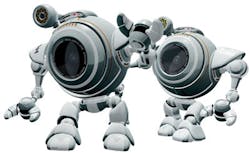The automotive industry has been the poster child in this arena, as it continued to drive component and subassembly prices steadily down with its suppliers. The food and beverage industries took a slightly different tack with industry consolidation and the rationalizing of manufacturing facilities in an effort to gain from manufacturing scales. In the pharmaceutical industry, the age of the blockbuster drug is over, and now the industry has placed a greater emphasis on manufacturing operations to improve margins.The latest generation of machine-vision technology offers significant benefits for applications outside the semiconductor industry, a primary past beneficiary of huge investments in the technology. Machine vision has brought end-users quantifiable benefits by boosting productivity on the production line and ensuring product quality, safety and security. The landscape is changing, as vision companies now provide end-to-end solutions for the pharmaceutical, food and beverage, and automotive industries. Today’s class of integrated vision systems provides solutions that enable manufacturers to meet regulatory requirements. These include commercially available vision solutions that satisfy both traceability and genealogy capabilities down to the component level.The need for regulatory compliance in pharmaceutical, food and beverage, and automotive industries has created opportunities for machine-vision technology in areas far beyond typical productivity and quality improvement applications. In response, suppliers have developed end-to-end vertical solutions that support many business and regulatory requirements.Support complianceMachine vision satisfies two key requirements of the pharmaceutical industry: (1) product quality, safety and security inspection in manufacturing, and (2) product tracking.The industry also has strict regulatory requirements for control system and software validation, as well as subsequent system changes and related procedures. Manufacturers are aware of the benefits of production-line flexibility, but the unique requirements of the pharmaceutical industry pose further challenges when considering flexibility. Pharmaceutical manufacturers must avoid the costly and lengthy revalidation process of software and control systems to comply with regulatory requirements for change management.Machine-vision systems play a critical role in food and beverage, pharmaceutical and other regulated manufacturing industries with heightened requirements for unit-level traceability due to produce liability, warranty costs, regulatory compliance and cost avoidance. Manufacturers need to contain potential quality problems before and after the product ships and provide detailed product genealogy information to supply-chain partners.Machine vision systems are available with production management or manufacturing execution system technology that provide end-to-end traceability solutions. Integrated machine-vision systems and production management software applications are the result of strategic alliances between machine-vision companies and enterprise software companies or integrators/original equipment manufactures (OEMs) to provide tightly coupled system solutions for component-level traceability and genealogy.The specific machine-vision system architecture is critical to minimize revalidation effort for software and systems on a production line. For example, when an additional camera is added to enhance the process on a currently operating production line, software will generally need to be modified and revalidated. Using a distributed architecture with software capable of expanding and adapting to additional cameras reduces, and may eliminate the need for revalidation of the existing application software. Emerging standard networking technologies, such as Gigabit Ethernet (GigE), also make change easier.Himanshu Shah, [email protected], is a Senior Analyst at ARC Advisory Group Inc., Dedham, Mass.
Subscribe to Automation World's RSS Feeds for Columns & Departments
About the Author
Sign up for our eNewsletters
Get the latest news and updates

Leaders relevant to this article:
